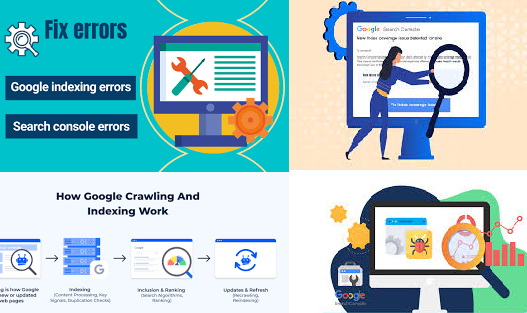Google indexing errors occur when Google’s crawlers have trouble accessing, interpreting, or cataloging a website's pages for search results. If pages aren't indexed, they won’t appear in search, limiting your site's visibility and potential traffic. Indexing errors can stem from technical issues, content duplication, poor site structure, or crawl budget limitations. Understanding the causes of these errors and knowing how to fix them is essential for ensuring your website is fully searchable and optimized for SEO.
Types of Google Indexing Errors
There are several common indexing errors that you may encounter in Google Search Console:- Crawl Anomalies
- Crawl anomalies are general errors that occur when Google’s bots encounter issues accessing a page. The cause could be a server error, broken link, or even a temporary block from the server.
- 404 Not Found Errors
- A 404 error appears when Google tries to index a URL that doesn’t exist on your site. It often results from deleted pages, misspelled URLs, or incorrect links.
- 500 Server Errors
- A 500 error occurs when the server is temporarily unavailable or has an internal issue. This prevents Google from accessing the page and indexing it.
- Blocked by Robots.txt
- If your robots.txt file blocks certain pages, Google’s crawlers won’t be able to access and index them. This file tells search engines which parts of your site should not be crawled.
- Duplicate Content with Canonical Tag Issues
- If there is duplicate content across multiple URLs, Google may not know which page to index, or it might index the wrong version. The canonical tag helps Google understand the primary version of a page.
- Submitted URL Not Found (404)
- When you submit a URL that doesn’t exist or was recently removed, Google returns a 404 error, indicating that the page can’t be indexed.
- Page with Redirect
- If a submitted URL redirects to another page, Google may not index it as intended. Redirect issues are common when URLs change but aren’t updated properly.
- Noindex Tag
- A “noindex” meta tag in your HTML instructs Google not to index the page. This can be useful for certain pages but might be problematic if used unintentionally.
How to Identify Google Indexing Errors
You can view indexing errors for your site in Google Search Console:- Go to Google Search Console.
- Select Coverage under the Index section.
- Review errors in the “Errors” section and warnings in the “Valid with Warnings” section.
- Click on specific errors to see the affected URLs and Google’s descriptions of the issues.
How to Fix Google Indexing Errors
Here are steps to resolve each of the common Google indexing errors:1. Fixing Crawl Anomalies
- Identify the Cause: Check the affected URLs and verify if they’re accessible on your server.
- Verify Links: Ensure all links to the page are correct and that your server isn’t overloaded.
- Retry Submission: If it’s a temporary server issue, resubmit the URL for indexing in Google Search Console after resolving the issue.
2. Resolving 404 Errors
- Create a Redirect: If a page is permanently removed, redirect the old URL to a relevant page (preferably using a 301 redirect).
- Update Links: Replace any internal links pointing to the removed page to prevent future 404 errors.
- Resubmit the URL: After setting up the redirect, resubmit the URL in Google Search Console.
3. Addressing 500 Server Errors
- Check Server Logs: Look into your server logs to identify the cause of the error and resolve it.
- Improve Server Reliability: Ensure your server can handle traffic and requests from Google’s crawlers without frequent errors.
4. Unblocking Robots.txt Restrictions
- Edit the Robots.txt File: Open your robots.txt file and make sure no critical pages are being blocked unintentionally.
- Use Google Search Console’s Robots.txt Tester: Verify your file to ensure Google can crawl all intended pages.
5. Fixing Duplicate Content Issues
- Add Canonical Tags: Use canonical tags to signal the primary version of a page, especially if the content appears on multiple URLs.
- Consolidate Duplicate Pages: Merge similar or identical pages to reduce redundancy and ensure one main page is indexed.
6. Removing “Noindex” Tags
- Edit Page Meta Tags: If the noindex tag is accidentally present, remove it from the HTML of the page.
- Resubmit for Indexing: Once the noindex tag is removed, resubmit the URL in Google Search Console.
7. Fixing Redirect Errors
- Update Redirects: Ensure each redirect points to the correct, relevant page. Avoid redirect chains where one URL redirects to another and another.
- Remove Unnecessary Redirects: If the page is no longer needed, set up a 301 redirect to a related page or update internal links accordingly.
8. Fixing Submitted URL Not Found (404) Errors
- Remove from Sitemap: If the page is no longer relevant, remove it from your sitemap and submit an updated version in Google Search Console.
- Redirect the URL: If the page has a replacement or similar content, create a 301 redirect to a related page.
Best Practices for Avoiding Google Indexing Errors
- Monitor Google Search Console Regularly: Regularly check your site’s status in Google Search Console to catch and resolve indexing issues early.
- Submit a Sitemap: Keep an updated sitemap to guide Google’s crawlers through your site structure.
- Optimize Internal Links: Proper internal linking can help Google discover and index your pages more efficiently.
- Use Structured Data: Structured data, like Schema markup, can help Google better understand and display your pages in search results.
- Minimize Duplicate Content: Duplicate content can confuse Google, so use unique titles, descriptions, and canonical tags to clarify page relevance.
